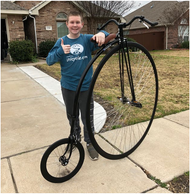Penny Farthings: Odd Bikes with Huge Front Wheels - But Why?
01/24/22
Have you ever seen those odd bikes with the larger front wheels - like comically larger, far larger than seems mechanically reasonable?
They are called penny farthing bikes, and they were probably the first machines to which the term “bicycle” was properly applied.
Yet, everything seems perplexingly wrong about them. The cranks are attached directly to the axle of the front wheel, which is preposterously large, making it difficult not only to mount the bike but to reach the pedals.
Modern bikes are alien by comparison. With their evenly sized wheels, ergonomic, sleek designs, and optimal pedal placement, they seem like precision machines.
There has to be a good reason for the odd design of the penny farthing since man is a creative tool-user. One would simply not create such an off form from mere fancy?
Right on all points. Let’s get into why those bikes have such ludicrously large front wheels.
No Chain Drive!
As it turns out, one of the main reasons that these odd bikes have such large front wheels is because they lack a chain drive. The idea of the chain drive is actually surprisingly old, potentially having been invented (in concept) by Leonardo da Vinci sometime in the 1400s. However, it was not applied to cycling until 1885, when the bike with the first chain drive was developed.
Penny farthings hit the scene in 1871, making them older than the first bikes with chain drives. Now, as you may well be familiar with, among other things, the chain drive gives an enormous mechanical advantage to cyclists, enabling them to attain higher speeds with less energy and effort.
Without a chain drive to amplify input energy, engineers had to go around and come up with another way to allow riders to reach higher speeds. One way was to increase the diameter and thus the circumference of the wheel actuated by the crank arms.
The advantage here is that the larger wheel makes it possible for riders to attain higher top speeds without the need for a chain drive. It makes it a lot harder to start the wheel, (and equally harder to stop it since the larger wheel acts like a flywheel and carries an enormous amount of rotational momentum) but it allows higher top speeds nonetheless.
The drawback is it also makes it a lot harder to mount the bike and considerably more difficult to control - but hey, higher speeds and no chain drive!

No Suspension
So the first, and main, reason that penny farthings have large front wheels is because it enables higher speed in the absence of a chain drive, but there is another reason - a very good one.
What we haven’t stated yet is that one of the earliest “prototypes” of bicycles was a contraption that also lacked a chain drive. It, however, was proportioned similarly to the bicycles of today, and it was propelled forward by the rider pushing off of the ground - although in some cases, the boneshaker might have pedals and crank arms attached to the front hub axle, in the same arrangement as a penny farthing.
It not only lacked a chain drive, though - it also lacked any semblance of a suspension system. It was known as the - wait for it - “boneshaker.”
It really takes only a little imagination to understand why this might be the case. These bikes offered a very poor ride quality, transferring all of the jolts and jars of an uneven road through the wheels, then the frame, and then, unmitigated, into the body of the rider.
It just so happens that these bikes were also difficult to steer and pedal at the same time, giving rise to other issues.
As for the large front wheel on the penny farthing - you guessed properly - it also happens to absorb the bumps and inconsistencies of uneven terrain or pavement. Like the boneshaker, it lacks a suspension system, but that larger front wheel can more smoothly ride over dips, bumps and other obstacles.
Be Careful Braking, Though!
Ultimately, the larger front wheel of this odd bike made it easier for riders to attain higher top speeds and to navigate coarse terrain - but it came at a price.
The larger wheel forced the rider to sit higher, putting the center of gravity of the contraption further off of the ground. Penny farthings were notoriously difficult to handle, and if a rider ever attempted to stop too abruptly, there was a chance that he or she would “take a header”, which in other words meant “fly headlong over the handlebars and into the ground”.

Risky, but the penny farthing still represented an improvement over other cycles of the day.
Thinking About Giving This Odd Bike a Try?
Despite the fact that these odd bikes are functionally obsolete today, there are still organizations around the world that are committed to riding and racing them. If you’re thinking about trying out a penny farthing, or are simply interested in history, you’ve come to the right place.
Check out our collection of odd bikes and see which one suits your tastes, and if you have any questions about any of our products, our customer service team would be more than happy to help - just give us a call at 678-494-4962.

